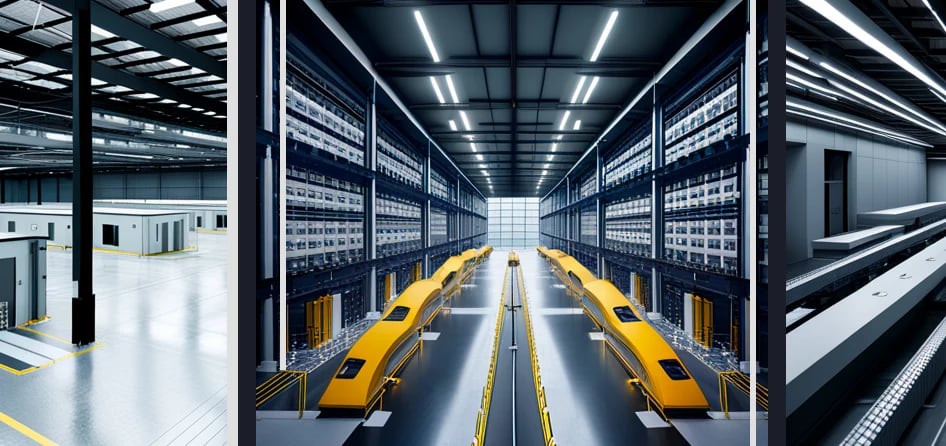

Digital technologies are revolutionizing warehouse operations, enhancing efficiency, reducing errors, and fostering a new level of customer visibility. This merger of cutting-edge technology and traditional warehousing practices provides a roadmap for the industry's sustainable future.
Several key digital trends are shaping the warehouse of the future, promising revolutionary changes. Blockchain technology and the Internet of Things (IoT) heighten transparency and foster real-time data exchange. According to the report from Statista, the global market for IoT is projected to grow to around 1.6 trillion by 2025, signifying the scale of IoT implementation in industries, including warehousing.
In addition, the shift from fixed workstations to mobile devices through warehouse mobility solutions is increasing operational efficiency. Similarly, Autonomous Guided Vehicles (AGVs) and drones are revolutionizing warehouse transport and inventory management. Advanced technologies such as machine learning and predictive analytics are optimizing inventory levels and anticipating future trends, with the global market for predictive analytics expected to reach USD 35.45 billion by 2027.
Integrating individuals and technology via smart wearables enhances visibility and reduces error rates. Automation and robotics are streamlining manual tasks, increasing efficiency, and are considered indispensable for the warehouse's future. Moreover, real-time inventory management systems are becoming crucial, providing greater visibility and control over inventory.
%202.webp?width=1979&height=1204&name=output%20(4)%202.webp)
The transformative power of digital technologies can be best understood by examining their impact within a logistics and supply chain company. A study by Natesan Andiyappillai, published in the International Journal of Computer Applications, reveals substantial improvements in warehouse activities such as receiving, picking, packing, shipping, and cycle count by 65%, thanks to RF handheld devices and Vehicle Mounted Units (VMU) integrated with Warehouse Management Systems (WMS). These devices have notably reduced the error rate from 12% to 3%.
Automation, including Conveyors, has resulted in a 48% increase in the volume of processed packages. Faster processing times and improved accuracy in product handling are the direct outcomes of integrating barcode scanners with WMS. Equally significant is the role of digital technologies in enhancing customer visibility, which has seen a 42% increase in communication speed.
The study underscores the importance of flexibility and productivity in modern warehousing. The digitized model allows warehouses to operate anywhere, anytime, and with any device, increasing workforce productivity by 18%. Advanced solutions such as Robots and Artificial Intelligence have facilitated continuous business operations without interruptions, resulting in a 51% increase in processing speed.
Real-time data and analytics are pivotal to the digital transformation of warehouse management. With continual access to real-time data, warehouse managers can make informed decisions, respond to changes promptly, and optimize workflows. Predictive analytics
Integrating digital technologies in warehouse management is not just beneficial—it's essential. Embracing technology increases efficiency, reduces errors, improves communication, and ultimately enhances customer satisfaction. As the industry digitalizes, businesses that adapt, innovate, and leverage these new tools will undoubtedly be the leaders of the future warehousing industry.
The challenge in the future is to continue this momentum, leveraging technology to deliver increased value to customers while maintaining competitiveness. As the digital revolution in warehouse management continues to evolve, companies must understand these trends and implement them effectively to reap the full benefits. The digital revolution in warehouse management brings advantages and challenges, including staying current with technological advancements, managing costs and skilled labor, and mitigating cyber threats to customer trust and company reputation.
The digital revolution in warehouse management is also drastically reshaping marketing and sales strategies within the industry. As warehouses become more transparent and efficient, businesses can leverage this to attract and retain clients. Real-time inventory management and data analytics, for instance, offer potential clients assurance of effective and efficient operations. Marketing campaigns can highlight the implementation of IoT and AI, demonstrating the warehouse's commitment to innovation and efficiency. A technologically advanced warehouse can effectively address customers' business challenges and provide a compelling value proposition. By leveraging technical advantages, it can deliver enhanced solutions and create greater customer value.
From a sales perspective, digital transformation enables streamlined and automated processes. With CRM integration, sales teams can monitor customer interactions, track leads, and manage customer relationships more effectively. This yields improved customer service and satisfaction, resulting in higher sales conversions.
Furthermore, mobile accessibility allows sales teams to access real-time inventory data, respond to customer inquiries swiftly, negotiate deals, and close sales from anywhere at any time. This flexibility significantly enhances the productivity and efficiency of the sales team.
While enhancing warehouse management operations, the digital revolution also presents a powerful tool to elevate marketing and sales performance in the warehousing industry. Companies that skillfully utilize these digital advancements will enhance their operational efficiency and gain a competitive edge in marketing and sales.
by Jonathan Franchell, CEO of Ironpaper - For more tips and hacks: Need to remove a new line after h1 tags? Both web designers and SEO practitioners need to employ headline tags: H1, H2, H3 in several ways to improve web page structure and tag...

The Crowded Arena of the IT Marketplace Updated December 2024 The Information Technology (IT) landscape is experiencing rapid growth and intensifying competition. IT spending is projected to reach nearly 5.1 trillion U.S. dollars in 2024, a...

The marketing industry is transforming significantly due to generative AI and increasing market complexity. Gartner's prediction of a 25% decline in traditional search traffic suggests that the era of search engines is dying. AI tools, particularly...

Updated December, 2024 The field of digital marketing is evolving rapidly in response to new technology and changing buyer expectations. To help career-minded marketers, we’ve rounded up the top 10 skills needed to succeed in the field. These are...
